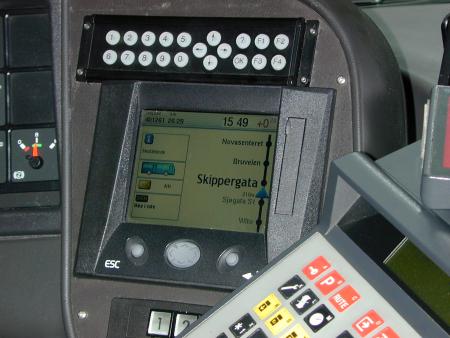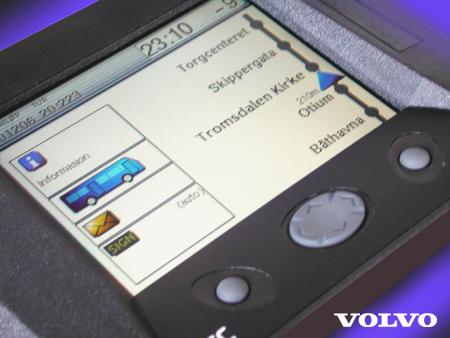Device Profile: Volvo ITS4mobility telematics system
Oct 22, 2003 — by LinuxDevices Staff — from the LinuxDevices Archive — 34 viewsIn Nordic countries, Volvo telematics division Volvo Mobility Systems (VMS) is computerizing public transit by adding rugged, radio-connected Linux systems that keep buses and trains running on time and forecast arrival times for waiting passengers. VMS's latest unit, ITS4mobility, is an Intelligent Transport System (ITS) integrated with a Real-Time Passenger Information (RTPI) system that enables tracking… of bus locations, two-way messaging, bus arrival forecasts, and other valuable functions. It can even provide “traffic control” capabilities, by signaling to traffic lights and requesting priority treatment!

Volvo Mobility Systems ITS4mobility in-vehicle device
VMS's Marketing Director Göran Varosy lists a pretty amazing set of functions that the ITS4mobility device can handle:
- Automatic assignments: Assignment of vehicles to transport services (i.e. vehicle ID, line, route, schedule, etc) on a specific operational day.
- Punctuality monitoring: The deviation of a vehicle from its timetable is continuously and automatically monitored and calculated. This is presented to the driver in his/her vehicle computer display and also sent to the Control Center.
- Automatic Vehicle Location (AVL): AVL makes it possible to geographically or logically determine the position of every vehicle in the public transport network. Position coordinates can be shown to the driver in the vehicle computer display and sent to the Control Center for presentation on a digital map.
- Two-way text messaging: It is possible for the Control Center to send/receive pre-defined and free-text messages to/from one driver, or alternatively a group of drivers or all drivers.
- Panic button (assault alarm): In case of an emergency, the driver can trigger this button, immediately sending a signal to the Control Center and/or the depot office to pinpoint the vehicle's exact location and status.
- Traffic signal priority: When a vehicle approaches a traffic light, it is given priority. It is possible to influence the level of priority depending on just how punctual the vehicle is.
- Real-time passenger information: Forecast information about expected arrival/departure times (i.e. real-time information plus historical statistics) is distributed continuously to the respective information displays/monitors at stops and to Travel Information Centers. This information can also be distributed via the Internet, mobile phones (WAP, SMS), and PDAs and any other appropriate means.
- Automatic interior/exterior sign control: This can be done manually or automatically. Vehicle external signs include route number and destination. Internal signs include route number, destination and other types of relevant travel information such as connections and system disruptions.
- Automatic next-stop announcement: This is done through visual announcements to passengers (via internal signs) and drivers (via the vehicle computer display) and/or voice announcements (via loudspeakers). The next-stop function keeps track of all the oncoming stops along the respective route.
- Service disruption information: Relevant information about temporary changes or current service disruptions in the system is also distributed continuously to the respective information displays/monitors at stops and to Travel Information Centers.
- Connecting buses: Information about key connections is presented both to drivers and passengers on board. This information is highly helpful when approaching critical transfer points.
ITS4mobility has been deployed in several Nordic cities. Tromso, Norway provides travel information in real-time for 17 of its 100 buses, with plans to link the whole system. In Gothenburg, Sweden, ITS4mobility tracks over 450 buses and trams, providing real-time passenger information to traffic controllers, information officers, to passengers at more than 140 at-stop displays, and also via the Internet and WAP. The on-board units will also be installed shortly on ferries operating in the public transport system of Gothenburg.

ITS4mobility in-vehicle device close-up
What's under the hood?
ITS4mobility runs a 58MHz Motorola MPC 823e, a high-integration system-on-chip device that combines the functions of a PowerPC microprocessor core, communication processor, and display controller within a single silicon component. The system boots from 16MB of Flash memory using JFFS2, a journaling filesystem for Flash memory devices that handles wear leveling and garbage collection and supports compression. The system has 32MB of RAM. The device includes a 5.5-inch 320 x 240 pixel color display.
ITS4mobility's wired interfaces include CAN (a fieldbus popular in vehicle applications), Ethernet, USB, RS232, and RS485. It can communicate with its Control Center using GPRS/GSM, TETRA, or Mobitex, and supports short-range data radio connections over WLAN, private radio, or inductive loop interfaces, according to Varosy.
Software
The device is based on MontaVista Hard Hat Linux 2.1, which was later renamed “Professional Edition,” with a 2.4.17 Linux kernel. The display is based on QT Embedded, an embedded Linux application development framework. A minimal command environment based on Busybox was also included.
VMS's hardware supplier, Finnish technical consulting firm Mitron, supplied Linux support along with MontaVista, according to Varosy, who commented that the biggest challenges related to Linux involved the USB driver for the MPC823e: “Mitron solved part of the problem, together with MontaVista. The result was a limited driver covering only what we needed.”
Why Linux?
Varosy says VMS chose Linux because it was already supported on the chosen hardware platform. But, the company was pleased with the choice and plans to use embedded Linux on future projects. “We will continue with Linux until there is a better os available, in terms of speed, stability, and flexibility. So far, there isn't any OS on the market that can compete with Linux for our products.”
Varosy notes that although its current real-time passenger information (RTPI), automatic vehicle location (AVL), fleet management, and telematics systems for public transport are marketed as retrofit systems to Scandinavian public transit agencies, VMS plans future products for new buses that will fully integrate RTPI and traffic control with vehicle and driver management functionality, increasing cost efficiency, quality, and customer usability.
“We are very happy we are running Linux, and we will definitely use it again,” emphasized Varosy.
This article was originally published on LinuxDevices.com and has been donated to the open source community by QuinStreet Inc. Please visit LinuxToday.com for up-to-date news and articles about Linux and open source.